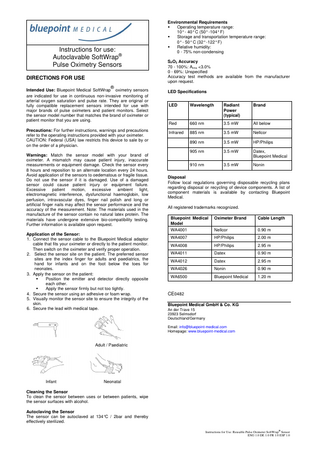bluepoint MEDICAL
Autoclavable SoftWrap Pulse Oximetry Sensors Directions for Use V1.0
Directions for Use
4 Pages

Preview
Page 1
Instructions for use: Autoclavable SoftWrap® Pulse Oximetry Sensors DIRECTIONS FOR USE ® Intended Use: Bluepoint Medical SoftWrap oximetry sensors are indicated for use in continuous non-invasive monitoring of arterial oxygen saturation and pulse rate. They are original or fully compatible replacement sensors intended for use with major brands of pulse oximeters and patient monitors. Select the sensor model number that matches the brand of oximeter or patient monitor that you are using. Precautions: For further instructions, warnings and precautions refer to the operating instructions provided with your oximeter. CAUTION: Federal (USA) law restricts this device to sale by or on the order of a physician. Warnings: Match the sensor model with your brand of oximeter. A mismatch may cause patient injury, inaccurate measurements or equipment damage. Check the sensor every 8 hours and reposition to an alternate location every 24 hours. Avoid application of the sensors to oedematous or fragile tissue. Do not use the sensor if it is damaged. Use of a damaged sensor could cause patient injury or equipment failure. Excessive patient motion, excessive ambient light, electromagnetic interference, dysfunctional haemoglobin, low perfusion, intravascular dyes, finger nail polish and long or artificial finger nails may affect the sensor performance and the accuracy of the measurement. Note: The materials used in the manufacture of the sensor contain no natural latex protein. The materials have undergone extensive bio-compatibility testing. Further information is available upon request. Application of the Sensor: 1. Connect the sensor cable to the Bluepoint Medical adaptor cable that fits your oximeter or directly to the patient monitor. Then switch on the oximeter and verify proper operation. 2. Select the sensor site on the patient. The preferred sensor sites are the index finger for adults and paediatrics, the hand for infants and on the foot below the toes for neonates. 3. Apply the sensor on the patient: Position the emitter and detector directly opposite each other. Apply the sensor firmly but not too tightly. 4. Secure the sensor using an adhesive or foam wrap. 5. Visually monitor the sensor site to ensure the integrity of the skin. 6. Secure the lead with medical tape.
Environmental Requirements Operating temperature range: 10° - 40° C (50° -104° F) Storage and transportation temperature range: 0° - 50° C (32° -122° F) Relative humidity: 0 - 75% non-condensing SPO2 Accuracy 70 - 100%: Arms <3.0% 0 - 69%: Unspecified Accuracy test methods are available from the manufacturer upon request. LED Specifications LED
Wavelength
Radiant Power (typical)
Brand
Red
660 nm
3.5 mW
All below
Infrared
885 nm
3.5 mW
Nellcor
890 nm
3.5 mW
HP/Philips
905 nm
3.5 mW
Datex, Bluepoint Medical
910 nm
3.5 mW
Nonin
Disposal Follow local regulations governing disposable recycling plans regarding disposal or recycling of device components. A list of component materials is available by contacting Bluepoint Medical. All registered trademarks recognized. Bluepoint Medical Model
Oximeter Brand
Cable Length
WA4001
Nellcor
0.90 m
WA4007
HP/Philips
2.00 m
WA4008
HP/Philips
2.95 m
WA4011
Datex
0.90 m
WA4012
Datex
2.95 m
WA4026
Nonin
0.90 m
WA6500
Bluepoint Medical
1.20 m
CE0482 Bluepoint Medical GmbH & Co. KG An der Trave 15 23923 Selmsdorf Deutschland/Germany Email: info@bluepoint-medical.com Homepage: www.bluepoint-medical.com
Adult / Paediatric
Infant
Neonatal
Cleaning the Sensor To clean the sensor between uses or between patients, wipe the sensor surfaces with alcohol. Autoclaving the Sensor The sensor can be autoclaved at 134°C / 2bar and thereby effectively sterilized. ®
Instructions for Use: Reusable Pulse Oximeter SoftWrap Sensor ENG 1.0 DE 1.0 FR 1.0 ESP 1.0